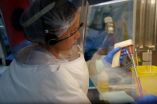(Press-News.org) This news release is available in French.
Performed in less than a month, sequencing of the complete genome and subsequent phylogenetic analysis show that the virus present in Guinea forms a clade (variant) that is distinct from strains previously identified in the Democratic Republic of Congo and in Gabon. Epidemiological investigations also linked the laboratory confirmed cases with the initial deaths recorded during the December 2013 outbreak.
Ebola virus is a lethal, highly contagious virus for which there is presently no treatment. The symptoms are somewhat non-specific, and include fever, severe diarrhoea and vomiting. Between 30 and 90% of those infected with this organism die as a result.
On 2 April 2014, the World Health Organisation (WHO), in a communiqué published by the UN, reported that it had recorded 5 new cases of Ebola fever in Guinea. Since January, the total number of suspected and confirmed cases of Ebola fever in the present outbreak in Guinea is 127, with 83 deaths, according to WHO, which states that 35 cases were confirmed by laboratory testing.
The initial samples were analysed in Lyon in the Jean Mérieux-Inserm BSL-4 Laboratory directed by Hervé Raoul, Inserm Research Director, by the French National Reference Centre for Viral Haemorrhagic Fevers (attached to the Biology of Viral Emerging Infections Unit at the Institut Pasteur, directed by Sylvain Baize). A positive diagnosis was made.
A mobile BSL-4 laboratory was deployed in Guinea to provide assistance with diagnosis in the field. This mobile laboratory was developed as part of a European project, "EMP4," coordinated by German researchers, and in which the Jean Mérieux-Inserm BSL-4 Laboratory is the French partner.
The researchers were able to analyse blood samples from 20 patients. Various tests were conducted by the scientists in order to establish a specific identity card for the virus.
Viral RNA was extracted from the blood samples, and then amplified and sequenced. These sequences were finally compared to 48 already known complete Ebola virus genomes. According to results, the analysis showed 97% identity with strains identified in the Democratic Republic of Congo in 1976 and 2007, and in Gabon in 1994 and 1996.
"These results demonstrate that we are facing the emergence of a new "form" of this virus in Guinea," explains Hervé Raoul, Director of the BSL-4 Laboratory. This form is common to cases discovered since the month of December.
It would appear that the epidemic originated from a single introduction from animal to human.
Apart from the present epidemic, these results show that the endemic area for Ebola virus is greater than previously known, and that as a consequence, West Africa should henceforth be considered an area of risk for Ebola virus. Measures aimed at preventing transmission from wild fauna to humans and quickly identifying such events if there is a recurrence must be put in place in Guinea, as well as in neighbouring countries.
INFORMATION:
Further information on the BSL-4 laboratory
The Jean Mérieux BSL-4 Laboratory is a high-level containment laboratory dedicated to the study of Class 4 pathogens. The biological safety level applied is 4, the highest possible level. The researchers working there wear a full body, air-supplied, positive pressure suit to protect them from all contamination. The laboratory is itself maintained under negative pressure in order to protect the environment. Moreover, all wastes produced are completely inactivated, and the exhaust air is purified by a double absolute filtration system. This laboratory currently remains the structure offering the largest experimental capacity in Europe for this containment level.
Highly pathogenic agents:
Class 4 pathogens (or risk group 4) are highly pathogenic microorganisms characterised by a very high mortality rate, a lack of prophylactic or therapeutic measures to provide protection, and ready transmissibility. All class 4 pathogens currently known are viruses, and include viruses that cause haemorrhagic fevers or encephalitis. They include the Ebola, Marburg, Lassa, Junin, Machupo, Guanarito, Sabia, Crimean-Congo, Nipah and Hendra viruses.
To obtain photographs of the BSL-4 laboratory: http://www.serimedis.inserm.fr/fr/feature/content/id/989
Sources:
Emergence of Zaire Ebola Virus Disease in Guinea — Preliminary Report
Sylvain Baize, Ph.D., Delphine Pannetier, Ph.D., Lisa Oestereich, M.Sc., Toni Rieger, Ph.D., Lamine Koivogui, Ph.D., N'Faly Magassouba, Ph.D., Barrè Soropogui, M.Sc., Mamadou Saliou Sow, M.D., Sakoba Keïta, M.D., Hilde De Clerck, M.D., Amanda Tiffany, M.P.H., Gemma Dominguez, B.Sc., Mathieu Loua, M.D., Alexis Traoré, M.D., Moussa Kolié, M.D., Emmanuel Roland Malano, M.D., Emmanuel Heleze, M.D., Anne Bocquin, M.Sc., Stephane Mély, M.Sc., Hervé Raoul, Ph.D., Valérie Caro, Ph.D., Dániel Cadar, D.V.M., Ph.D., Martin Gabriel, M.D., Meike Pahlmann, Ph.D., Dennis Tappe, M.D., Jonas Schmidt-Chanasit, M.D., Benido Impouma, M.D., Abdoul Karim Diallo, M.D., Pierre Formenty, D.V.M., M.P.H., Michel Van Herp, M.D., M.P.H., and Stephan Günther, M.D.
New England Journal of Medicine, 16 April 2014, http://dx.doi.org/10.1056/NEJMoa1404505
Researcher contact:
Inserm
Delphine Pannetier
+33 (0)4 72 76 82 91
delphine.pannetier@inserm.fr
Institut Pasteur
Sylvain Baize
+33 (0)4 37 28 24 43
sylvain.baize@pasteur.fr
Press contact
presse@inserm.fr END
Inserm and the Institut Pasteur identify a new variant of Ebola virus in Guinea
2014-04-22
ELSE PRESS RELEASES FROM THIS DATE:
How the body fights against viruses
2014-04-22
This news release is available in German. Scientists of the Max F. Perutz Laboratories of the University of Vienna and the Medical University of Vienna, together with colleagues of the ETH Zurich, have now shown how double stranded RNA, such as viral genetic information, is prevented from entering the nucleus of a cell. During the immune response against viral infection, the protein ADAR1 moves from the cell nucleus into the surrounding cytoplasm. There it modifies viral RNA to inhibit reproduction of the virus. But how is the human genome protected from inadvertent ...
What gave us the advantage over extinct types of humans?
2014-04-22
Jerusalem, April 22, 2014 -- In parallel with modern man (Homo sapiens), there were other, extinct types of humans with whom we lived side by side, such as Neanderthals and the recently discovered Denisovans of Siberia. Yet only Homo sapiens survived. What was it in our genetic makeup that gave us the advantage?
The truth is that little is known about our unique genetic makeup as distinguished from our archaic cousins, and how it contributed to the fact that we are the only species among them
to survive. Even less is known about our unique epigenetic makeup, but it ...
Turoctocog alfa in patients with hemophilia A: Added benefit not proven
2014-04-22
Turoctocog alfa (trade name: NovoEight) has been approved since November 2013 for the prevention and treatment of bleeding in patients with haemophilia A. In an early benefit assessment pursuant to the "Act on the Reform of the Market for Medicinal Products" (AMNOG), the German Institute for Quality and Efficiency in Health Care (IQWiG) examined whether this new active ingredient offers an added benefit over the appropriate comparator therapy.
According to the findings, an added benefit of turoctocog alfa is not proven. As no relevant study is available for comparison ...
Life stressors trigger neurological disorders, researchers find
2014-04-22
Washington, DC -- When mothers are exposed to trauma, illness, alcohol or other drug abuse, these stressors may activate a single molecular trigger in brain cells that can go awry and activate conditions such as schizophrenia, post-traumatic stress disorder and some forms of autism.
Until now, it has been unclear how much these stressors have impacted the cells of a developing brain. Past studies have shown that when an expectant mother exposes herself to alcohol or drug abuse or she experiences some trauma or illness, her baby may later develop a psychiatric disorder, ...
Ask yourself: Will you help the environment?
2014-04-22
This news release is available in French. Whether it's recycling, composting or buying environmentally friendly products, guilt can be a strong motivator — not just on Earth Day.
Now, research from Concordia University's John Molson School of Business published in the Journal of Business Ethics, proves that even just asking ourselves, or predicting, whether we will engage in sustainable shopping behaviour can increase the likelihood of following through — especially when there's an audience.
Lead author, marketing professor Onur Bodur explains that, "this is because ...
Brain size matters when it comes to animal self-control
2014-04-22
Chimpanzees may throw tantrums like toddlers, but their total brain size suggests they have more self-control than, say, a gerbil or fox squirrel, according to a new study of 36 species of mammals and birds ranging from orangutans to zebra finches.
Scientists at Duke University, UC Berkeley, Stanford, Yale and more than two-dozen other research institutions collaborated on this first large-scale investigation into the evolution of self-control, defined in the study as the ability to inhibit powerful but ultimately counter-productive behavior. They found that the species ...
Male health linked to testosterone exposure in womb, study finds
2014-04-22
Men's susceptibility to serious health conditions may be influenced by low exposure to testosterone in the womb, new research suggests.
A study has revealed how men's testosterone levels may be determined before they are born.
Understanding why some men have less of the hormone than others is important because testosterone is crucial for life-long health. Low levels of the hormone have been linked to obesity, diabetes and heart disease.
Researchers have shown that the cells responsible for producing testosterone in adults – known as Leydig cells – are derived from ...
FASEB releases updated NIH state factsheets
2014-04-22
The Federation of American Societies for Experimental Biology (FASEB) has released updated factsheets for fiscal year (FY) 2013 highlighting how funding from the National Institutes of Health (NIH) benefits each of the 50 states, DC, and Puerto Rico. "FASEB is pleased to make these factsheets available to help citizens and policymakers understand the significance of NIH to their state," said FASEB President, Margaret K. Offermann, MD, PhD. NIH is the nation's leading source for biomedical research funding, investing $29.2 billion in FY 2013 in medical research, 80 percent ...
Report recommends insurers use prescription monitoring data to reduce opioid abuse, deaths
2014-04-22
WALTHAM, Mass. – The Prescription Drug Monitoring Program Center of Excellence at Brandeis University has issued a ground-breaking report recommending that medical insurers use prescription monitoring data to reduce the overdoses, deaths and health care costs associated with abuse of opioids and other prescription drugs.
"At a time when the misuse and abuse of prescription opioids has reached epidemic levels, it's important that third party payers be able to use states' prescription monitoring data to make sure these drugs are prescribed appropriately," said Peter Kreiner, ...
RNA shows potential as boiling-resistant anionic polymer material for nanoarchitectures
2014-04-22
A team of nanotechnology researchers at the University of Kentucky has discovered new methods to build heat resistant nanostructures and arrays using RNA.
The research, led by Peixuan Guo, professor and William Farish Endowed Chair in Nanobiotechnology at the UK College of Pharmacy and Markey Cancer Center, is reported in an article titled "RNA as a Boiling-Resistant Anionic Polymer Material To Build Robust Structures with Defined Shape and Stoichiometry," coauthored by Emil F. Khisamutdinov and Daniel L. Jasinski.
The article, which will appear in a forthcoming edition ...




